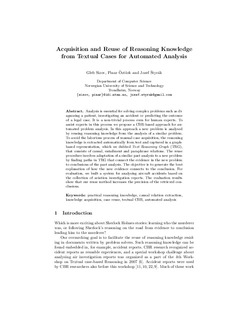Acquisition and Reuse of Reasoning Knowledge from Textual Cases for Automated Analysis
Journal article
Permanent lenke
http://hdl.handle.net/11250/2393961Utgivelsesdato
2009Metadata
Vis full innførselSamlinger
Originalversjon
[Eds.] Lecture Notes in Computer Science p. 465-479 Lecture Notes in Computer Science, Springer, 2009 10.1007/978-3-319-11209-1_33Sammendrag
Analysis is essential for solving complex problems such as diagnosing a patient, investigating an accident or predicting the outcome of a legal case. It is a non-trivial process even for human experts. To assist experts in this process we propose a CBR-based approach for automated problem analysis. In this approach a new problem is analysed by reusing reasoning knowledge from the analysis of a similar problem. To avoid the laborious process of manual case acquisition, the reasoning knowledge is extracted automatically from text and captured in a graph-based representation, which we dubbed Text Reasoning Graph (TRG), that consists of causal, entailment and paraphrase relations. The reuse procedure involves adaptation of a similar past analysis to a new problem by finding paths in TRG that connect the evidence in the new problem to conclusions of the past analysis. The objective is to generate the best explanation of how the new evidence connects to the conclusion. For evaluation, we built a system for analysing aircraft accidents based on the collection of aviation investigation reports. The evaluation results show that our reuse method increases the precision of the retrieved conclusions.
